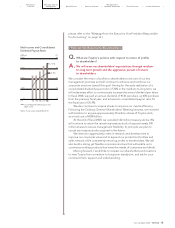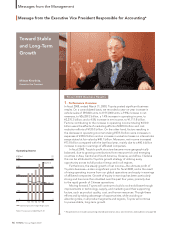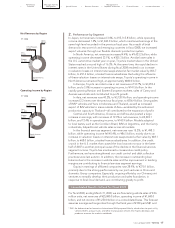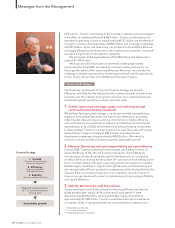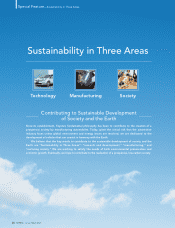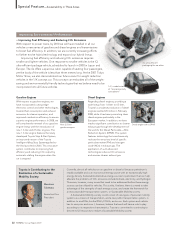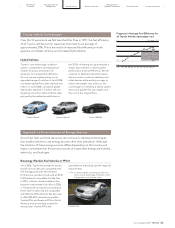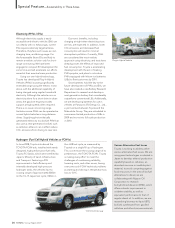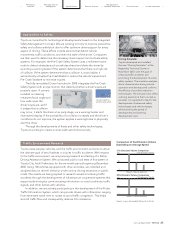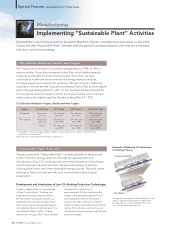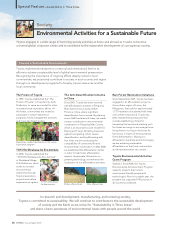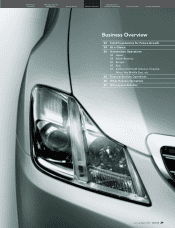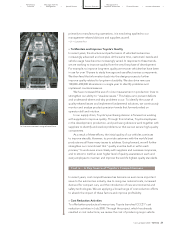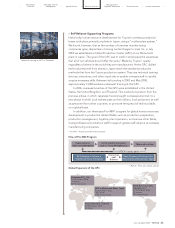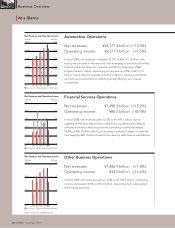Toyota 2008 Annual Report Download - page 26
Download and view the complete annual report
Please find page 26 of the 2008 Toyota annual report below. You can navigate through the pages in the report by either clicking on the pages listed below, or by using the keyword search tool below to find specific information within the annual report.
24 TOYOTA •Annual Report 2008 •
Special Feature—Sustainability in Three Areas
In June 2008, Toyota introduced the
TOYOTA FCHV-adv, installed with newly
designed, high-performance fuel cells,
Toyota FC Stacks, which were certified by
Japan’s Ministry of Land, Infrastructure
and Transport. Featuring a 25%
improvement in fuel efficiency and
internally developed high-pressure
hydrogen tanks, the vehicles have a
cruising range of approximately 830km
(in the 10–15 Japan test cycle; 760km in
the Jc08 test cycle; as measured by
Toyota) on a single fill up of hydrogen.
This is over twice the cruising range of its
predecessor, the TOYOTA FCHV. Toyota
is making every effort to meet the
challenges of maintaining reliability,
lowering costs, and other issues, having
overcome such FCHV technical problems
as starting and driving in temperatures as
low as -30ºC.
Hydrogen (Fuel Cell Hybrid Vehicles or FCHVs)
Although electricity supply is easily
accessible and electric vehicles (EVs) can
run cleanly with no exhaust gas, current
EVs require extremely large batteries.
Therefore, they face such issues as cost,
charging time, and driving range. For
the foreseeable future EVs are likely to
remain a realistic solution only for short-
range commuting. We have been
engaged in compact EV development for
some time and will accelerate our efforts
aimed at their eventual mass production.
Using our own hybrid technology,
Toyota has developed Plug-In Hybrid
Vehicles (PHVs) boasting significantly
extended range using the electric motor
alone, with the additional capability of
being charged using regular household
electricity. Although the vehicle runs on
electricity alone for a short drive in urban
areas, the gasoline engine provides
support at high speeds when required.
There is no issue concerning range
limitations since PHVs can be operated as
normal hybrid vehicles in long-distance
drives. Supplying photovoltaically
generated electricity to a biofuel PHV that
also uses a next-generation biofuel, such
as cellulosic ethanol, can in effect reduce
CO2emissions from driving to near zero.
Economic benefits, including
charging at night when electricity prices
are low, are expected. In addition, lower
CO2emissions and decreased fuel
consumption will result in minimal
atmospheric pollution. Currently, PHVs
are considered the most realistic
approach using electricity, and tests have
already proven the effects of improved
fuel consumption. Toyota is accelerating
development with the aim of making
PHVs popular, and plans to introduce
PHVs equipped with lithium-ion batteries
(LIBs) to fleet customers by 2010.
Since batteries hold the key to the
future development of PHVs and EVs, we
have also created a new Battery Research
Department to research and develop a
next-generation battery that considerably
outperforms conventional LIBs. Additionally,
we are developing batteries for use in
vehicles at Panasonic EV Energy Co., Ltd.,
a joint venture between Toyota and the
Matsushita Group. They are scheduled to
commence limited production of LIBs in
2009 and move into full-scale production
in 2010.
Electricity (PHVs / EVs)
Various Alternative Fuel Issues
Toyota is working to address other
various alternative fuel issues. We are
using yeast technologies incubated in
Japan to develop ethanol production
capability based on cellulose, an
abundant resource in inedible plant
material, to avoid competing against
food resources. In the area of biofuel
alternatives to diesel, we are
collaborating with Nippon Oil
Corporation to research
biohydrofined diesel oil (BHD), which
offers a drastic improvement in
oxidative stability, as well as
equivalent performance to that of
regular diesel oil. In addition, we are
researching biomass-to-liquid (BTL)
biofuels synthesized from gasified
cellulose and other biomass materials.
Plug-in Hybrid Vehicle
TOYOTA FCHV-adv



